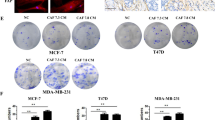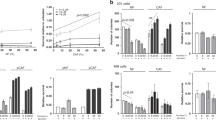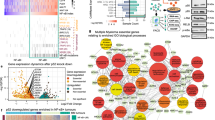Abstract
p53 is the most frequently inactivated gene in human cancers, reflecting its pivotal role in maintaining genomic integrity. The present study was conducted to explore the possibility that tumour cells with no intrinsic defects of the p53 pathway might nevertheless acquire p53 dysfunction through extrinsic suppression of the pathway by microenvironmental factors. Neoplastic cells from patients with chronic lymphocytic leukaemia (CLL) were cultured in the presence or absence of basic fibroblast growth factor (bFGF) and exposed to ionizing radiation (IR) to induce p53 accumulation. bFGF is greatly increased in the plasma of CLL patients and can suppress p53 activation in some experimental models. IR induced a marked increase in p53 levels in 28 samples from 24 patients. bFGF inhibited IR-induced p53 accumulation to some extent in most of these samples and by more than 50% in seven samples from seven patients. Suppression of p53 activation by bFGF was frequently but not always accompanied by upregulation of the p53-inhibitory protein MDM2 and/or phosphorylation of MDM2 at serine 166, and was associated with impaired transcriptional activation of the p53 target gene p21. These observations provide the first demonstration in human cancer cells that the p53 pathway can be suppressed by factors in the tumour-cell microenvironment.
This is a preview of subscription content, access via your institution
Access options
Subscribe to this journal
Receive 50 print issues and online access
$259.00 per year
only $5.18 per issue
Buy this article
- Purchase on Springer Link
- Instant access to full article PDF
Prices may be subject to local taxes which are calculated during checkout




Similar content being viewed by others
References
Aguayo A, Kantarjian H, Manshouri T, Gidel C, Estey E, Thomas D, Koller C, Estrov Z, O'Brien S, Keating M, Freireich E and Albitar M . (2000). Blood, 96, 2240–2245.
Ashcroft M, Ludwig RL, Woods DB, Copeland TD, Weber HO, MacRae EJ and Vousden KH . (2002). Oncogene, 21, 1955–1962.
Ashton AW, Cheng Y, Helisch A and Ware JA . (2004). Circ. Res., 94, 735–742.
Bairey O, Zimra Y, Shaklai M and Rabizadeh E . (2001). Br. J. Haematol., 113, 400–406.
Bourdon JC, De Laurenzi V, Melino G and Lane D . (2003). Cell Death Differ., 10, 397–399.
Brooks CL and Gu W . (2003). Curr. Opin. Cell Biol., 15, 164–171.
Buschmann T, Potapova O, Bar-Shira A, Ivanov VN, Fuchs SY, Henderson S, Fried VA, Minamoto T, Alarcon-Vargas D, Pincus MR, Gaarde WA, Holbrook NJ, Shiloh Y and Ronai Z . (2001). Mol. Cell. Biol., 21, 2743–2754.
Deguchi Y, Okutsu H, Okura T, Yamada S, Kimura R, Yuge T, Furukawa A, Morimoto K, Tachikawa M, Ohtsuki S, Hosoya K and Terasaki T . (2002). J. Neurochem., 83, 381–389.
Dode C, Levilliers J, Dupont JM, De Paepe A, Le Du N, Soussi-Yanicostas N, Coimbra RS, Delmaghani S, Compain-Nouaille S, Baverel F, Pecheux C, Le Tessier D, Cruaud C, Delpech M, Speleman F, Vermeulen S, Amalfitano A, Bachelot Y, Bouchard P, Cabrol S, Carel JC, Delemarre-van de Waal H, Goulet-Salmon B, Kottler ML, Richard O, Sanchez-Franco F, Saura R, Young J, Petit C and Hardelin JP . (2003). Nat. Genet., 33, 463–465.
Fuchs SY, Adler V, Pincus MR and Ronai Z . (1998). Proc. Natl. Acad. Sci. USA, 95, 10541–10546.
Gora-Tybor J, Blonski JZ and Robak T . (2002). Neoplasma, 49, 145–148.
Gora-Tybor J, Blonski JZ and Robak T . (2003). Mediators Inflamm., 12, 167–171.
Hosokawa K, Aharoni D, Dantes A, Shaulian E, Schere-Levy C, Atzmon R, Kotsuji F, Oren M, Vlodavsky I and Amsterdam A . (1998). Endocrinology, 139, 4688–4700.
Kay NE, Bone ND, Tschumper RC, Howell KH, Geyer SM, Dewald GW, Hanson CA and Jelinek DF . (2002). Leukemia, 16, 911–919.
Krejci P, Dvorakova D, Krahulcova E, Pachernik J, Mayer J, Hampl A and Dvorak P . (2001). Leukemia, 15, 228–237.
Lane DP . (1992). Nature, 358, 15–16.
Lin K, Sherrington PD, Dennis M, Matrai Z, Cawley JC and Pettitt AR . (2002). Blood, 100, 1404–1409.
Lowe SW, Ruley HE, Jacks T and Housman DE . (1993). Cell, 74, 957–967.
Mayo LD and Donner DB . (2001). Proc. Natl. Acad. Sci. USA, 98, 11598–11603.
Menzel T, Rahman Z, Calleja E, White K, Wilson EL, Wieder R and Gabrilove J . (1996). Blood, 87, 1056–1063.
Molica S, Vitelli G, Levato D, Ricciotti A and Digiesi G . (2002). Br. J. Cancer, 86, 31–35.
Nguyen M, Watanabe H, Budson AE, Richie JP, Hayes DF and Folkman J . (1994). J. Natl. Cancer Inst., 86, 356–361.
Ogawara Y, Kishishita S, Obata T, Isazawa Y, Suzuki T, Tanaka K, Masuyama N and Gotoh Y . (2002). J. Biol. Chem., 277, 21843–21850.
Oren M . (2003). Cell Death Differ., 10, 431–442.
Pardo OE, Arcaro A, Salerno G, Tetley TD, Valovka T, Gout I and Seckl MJ . (2001). Oncogene, 20, 7658–7667.
Pettitt AR . (2003). Br. J. Haematol., 121, 692–702.
Pettitt AR, Sherrington PD, Stewart G, Cawley JC, Taylor AM and Stankovic T . (2001). Blood, 98, 814–822.
Qiao D, Meyer K, Mundhenke C, Drew SA and Friedl A . (2003). J. Biol. Chem., 278, 16045–16053.
Sax JK and El-Deiry WS . (2003). Cell Death Differ., 10, 413–417.
Sebestyen A, Berczi L, Mihalik R, Matolcsy A and Kopper L . (1999). Br. J. Haematol., 104, 412–419.
Sebestyen A, Kovalszky I, Mihalik R, Gallai M, Bocsi J, Laszlo E, Benedek S, Sreter L and Kopper L . (1997). Eur. J. Cancer, 33, 2273–2277.
Shaulian E, Resnitzky D, Shifman O, Blandino G, Amsterdam A, Yayon A and Oren M . (1997). Oncogene, 15, 2717–2725.
She QB, Bode AM, Ma WY, Chen NY and Dong Z . (2001). Cancer Res., 61, 1604–1610.
She QB, Ma WY and Dong Z . (2002). Oncogene, 21, 1580–1589.
Stankovic T, Stewart GS, Fegan C, Biggs P, Last J, Byrd PJ, Keenan RD, Moss PA and Taylor AM . (2002). Blood, 99, 300–309.
Sutcliffe M, Oscier D and Wright DH . (2000). Br. J. Haematol., 110, 239–240.
Wattel E, Preudhomme C, Hecquet B, Vanrumbeke M, Quesnel B, Dervite I, Morel P and Fenaux P . (1994). Blood, 84, 3148–3157.
Witzig TE, Kimlinger T, Stenson M and Therneau T . (1998). Leuk. Lymphoma., 31, 167–175.
Xu Y . (2003). Cell Death Differ., 10, 400–403.
Yayon A, Klagsbrun M, Esko JD, Leder P and Ornitz DM . (1991). Cell, 64, 841–848.
Zhu Y, Mao XO, Sun Y, Xia Z and Greenberg DA . (2002). J. Biol. Chem., 277, 22909–22914.
Acknowledgements
Thanks are due to Mr Anthony Carter for his help with FACS analysis. The work was supported by grants from the UK Leukaemia Research Fund and the Royal Liverpool and Broadgreen University Hospitals R&D Support Fund.
Author information
Authors and Affiliations
Corresponding author
Rights and permissions
About this article
Cite this article
Romanov, V., James, C., Sherrington, P. et al. Basic fibroblast growth factor suppresses p53 activation in the neoplastic cells of a proportion of patients with chronic lymphocytic leukaemia. Oncogene 24, 6855–6860 (2005). https://doi.org/10.1038/sj.onc.1208895
Received:
Revised:
Accepted:
Published:
Issue Date:
DOI: https://doi.org/10.1038/sj.onc.1208895
Keywords
This article is cited by
-
Hsp90 inhibition has opposing effects on wild-type and mutant p53 and induces p21 expression and cytotoxicity irrespective of p53/ATM status in chronic lymphocytic leukaemia cells
Oncogene (2008)
-
RNA interference of LRRK2–microarray expression analysis of a Parkinson’s disease key player
Neurogenetics (2008)



